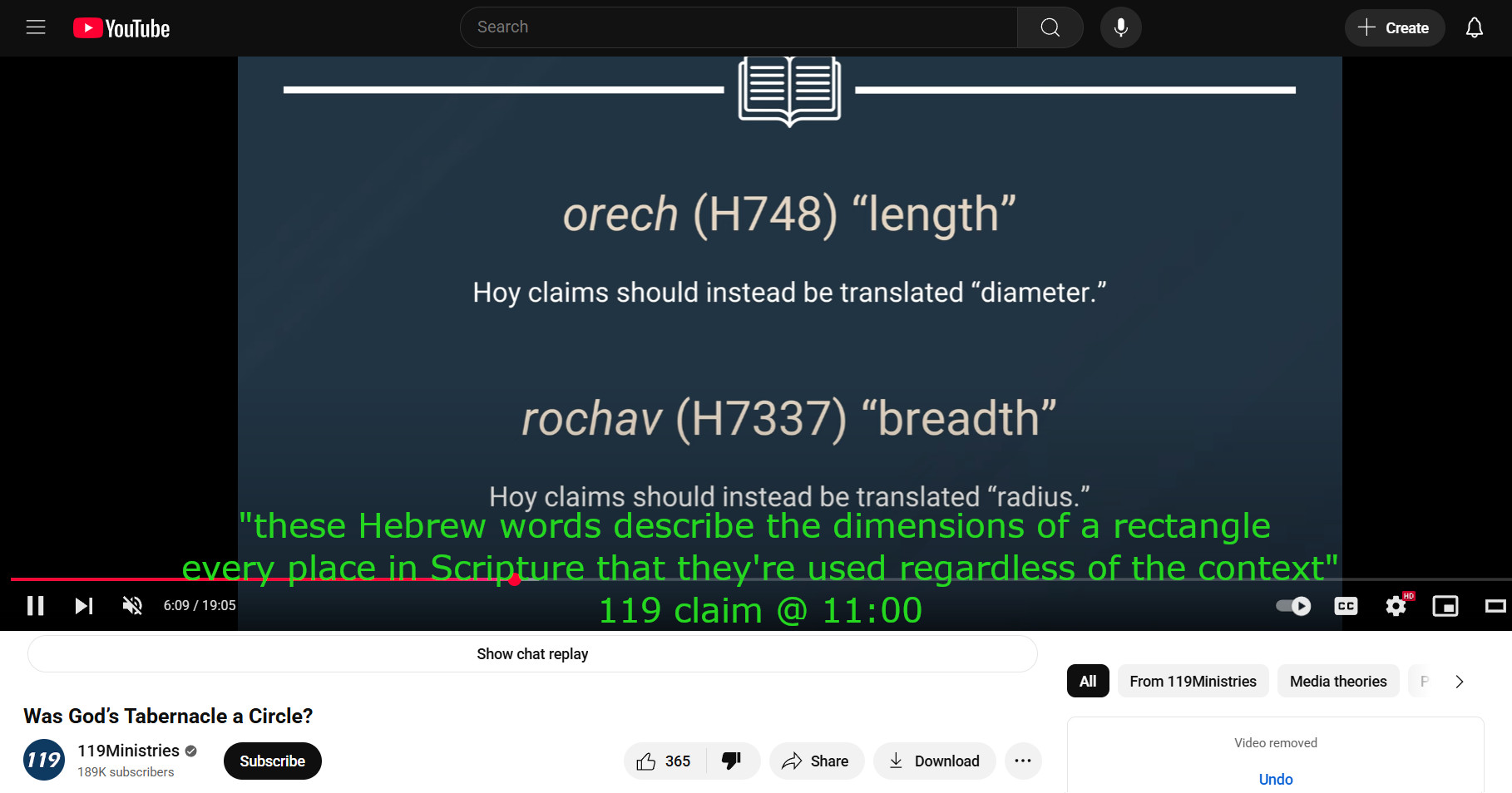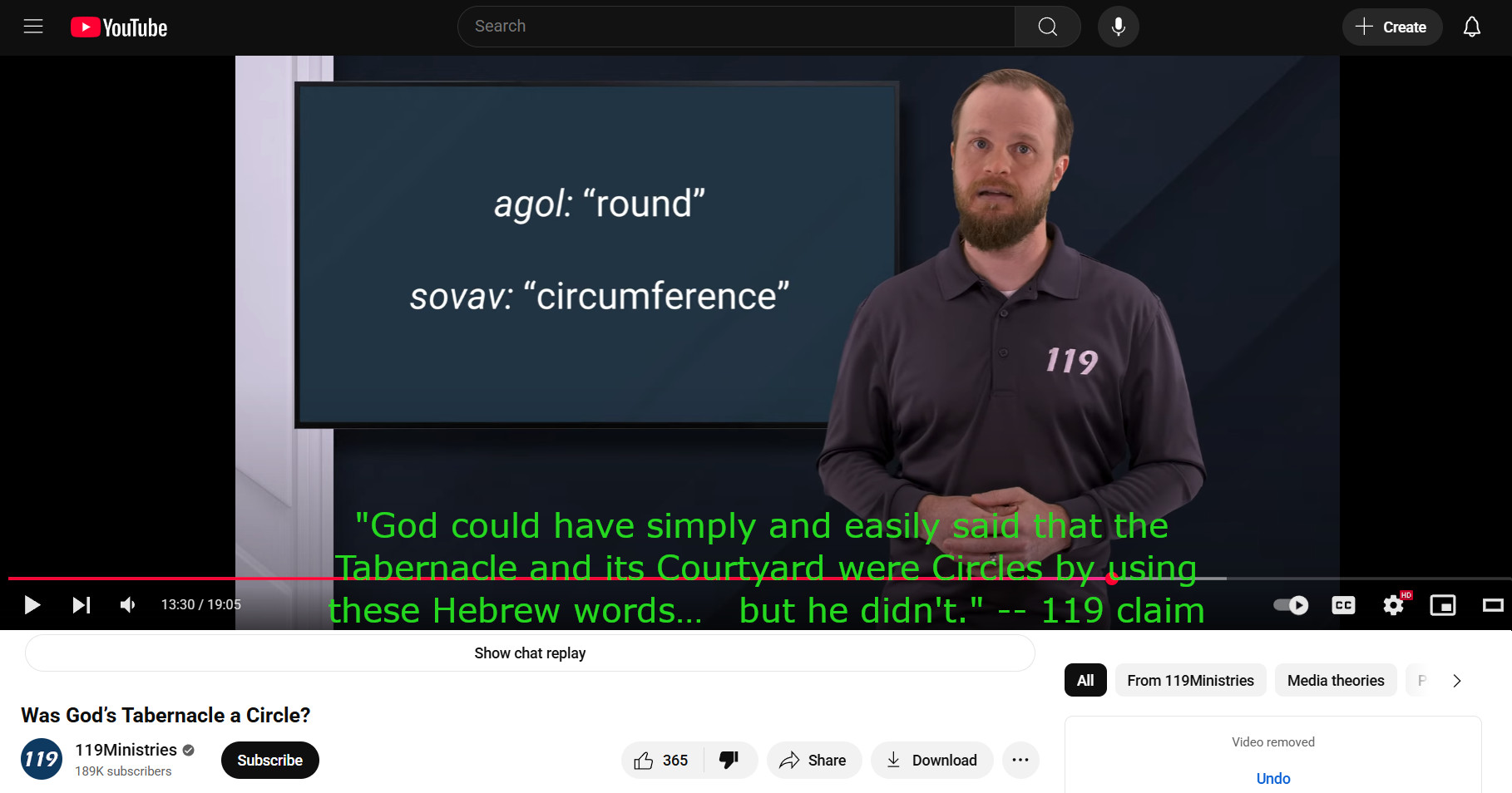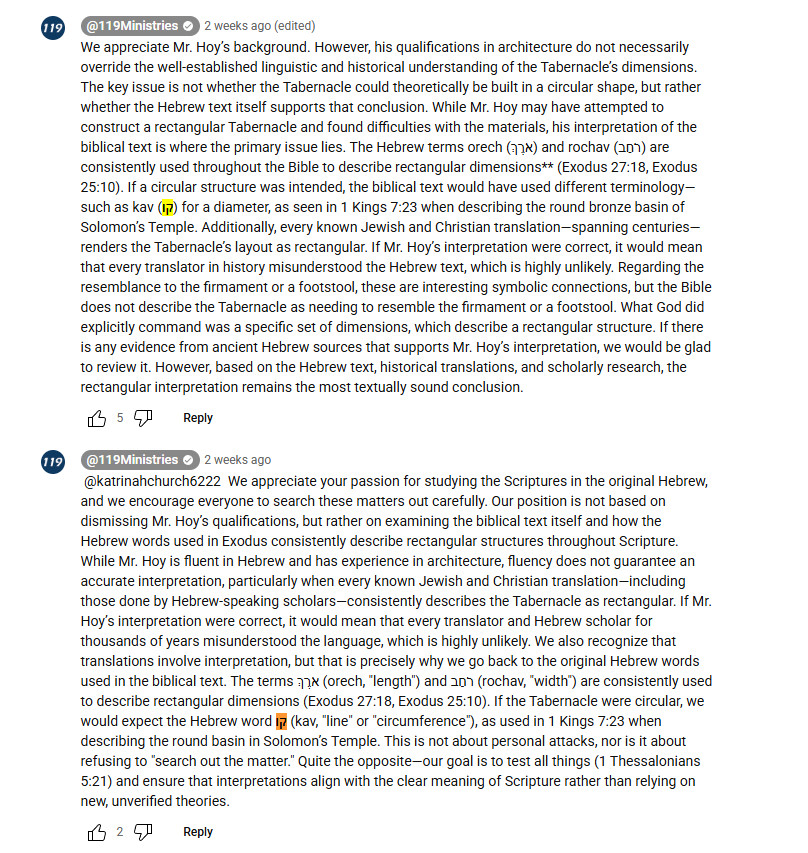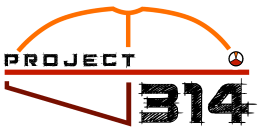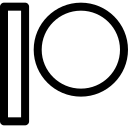In February of 2025, 119 Ministries posted a video entitled, "Was God's Tabernacle a Circle" under the pretense of "testing everything", specifically in this case, the round Tabernacle discovery. While the 119 team member challenged all of but two claims pertaining to the round Tabernacle discovery, the vast majority of the "teaching" video was really an apologetic for the rectangular Tabernacle. But were the rectangular models that the 119 team showcased in their video in effort to refute the round Tabernacle claim ever tested in accordance with Bible specifications, or real-world physics? A careful look at their published content would require one to respond with a resounding "NO", and would reveal a grotesque amount of discrepancies in the models and reasoning put forth by the 119 Ministries team.
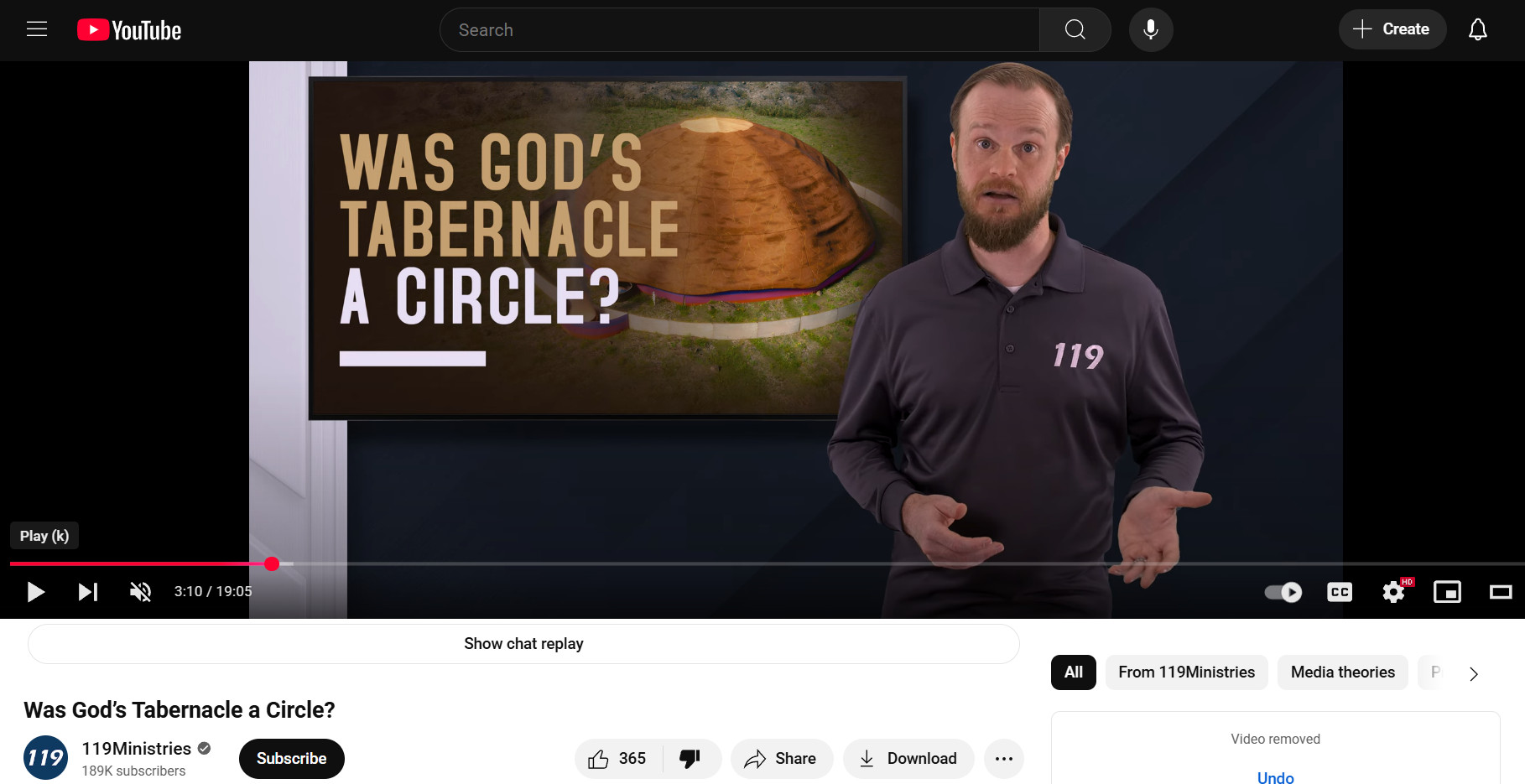
The Proverbs say that "the first to present his case sounds right, until another comes along and questions him". This is most certainly true in the case of the 119 Ministries video. After all, it's easy to look at two Hebrew words like "orech" and "rochav" or ארך and רחב in Hebrew, which merely means "length and width", and claim that the structure "MUST BE a RECTANGLE" based upon one single verse like Exodus 27:18, which in translation usually seems to describe a rectangle measuring 100 x 50 cubits. But what if I told you that the Hebrew text actually specified a courtyard that measured 100 cubits in length and 50 by 50 cubits in width and 5 cubits in height? Suddenly, given the FOUR dimensions specified in the Hebrew Exodus texts, including TWO curious width dimensions, it becomes a little more difficult to make the claim that what's being described here is just an ordinary rectangle which can be specified by or conveyed with only two dimensions.
But what if I told you that there was still more to the story? What if in their zeal and ignorance the 119 team haphazardly missed dozens--almost dozens of dozens--of details in the Hebrew texts that describe the Tabernacle as they were showing and endorsing rectangular models as visual teaching supplements? How would you know what was true and tested? Well, because the 119 team posted dysfunctional rectangular models examples as being representative of the Exodus text, I have taken the time to flag the many nonconformances--which 119 (and many other parties) have carelessly overlooked. In fact, in honor of 119's "test everything" claim and numeric corporate branding, I've identified 119 "transgressions" against the Tabernacle as committed by 119 in their "hit-and-run" presentation. I say "hit-and-run" presentation because 119 not only failed to ask me any questions before defaming my work and bearing false witness, but because they also declined a challenge to debate following their video posting, and have gone so far as to block and censor my responses within their social media (facebook page). Hopefully, given the list of discrepancies below, you'll not only see not only how they can't count, but how they can't identify shapes, how they can't cite the proper Hebrew... and why they run and hide when challenged (this "test everything" ministry has yet to respond to my 119 questions that I've made in response). Needless to say, there is good reason that public accountability and quality of workmanship are intrinsically linked.
For public consideration, what I'd refer to as "119 Transgressions against the Tabernacle" are itemized and illustrated the the charts and images below. The images were extracted directly from the 119 video, along with timestamps, should the audience be curious as to the exact source of 119's representative images shown below.
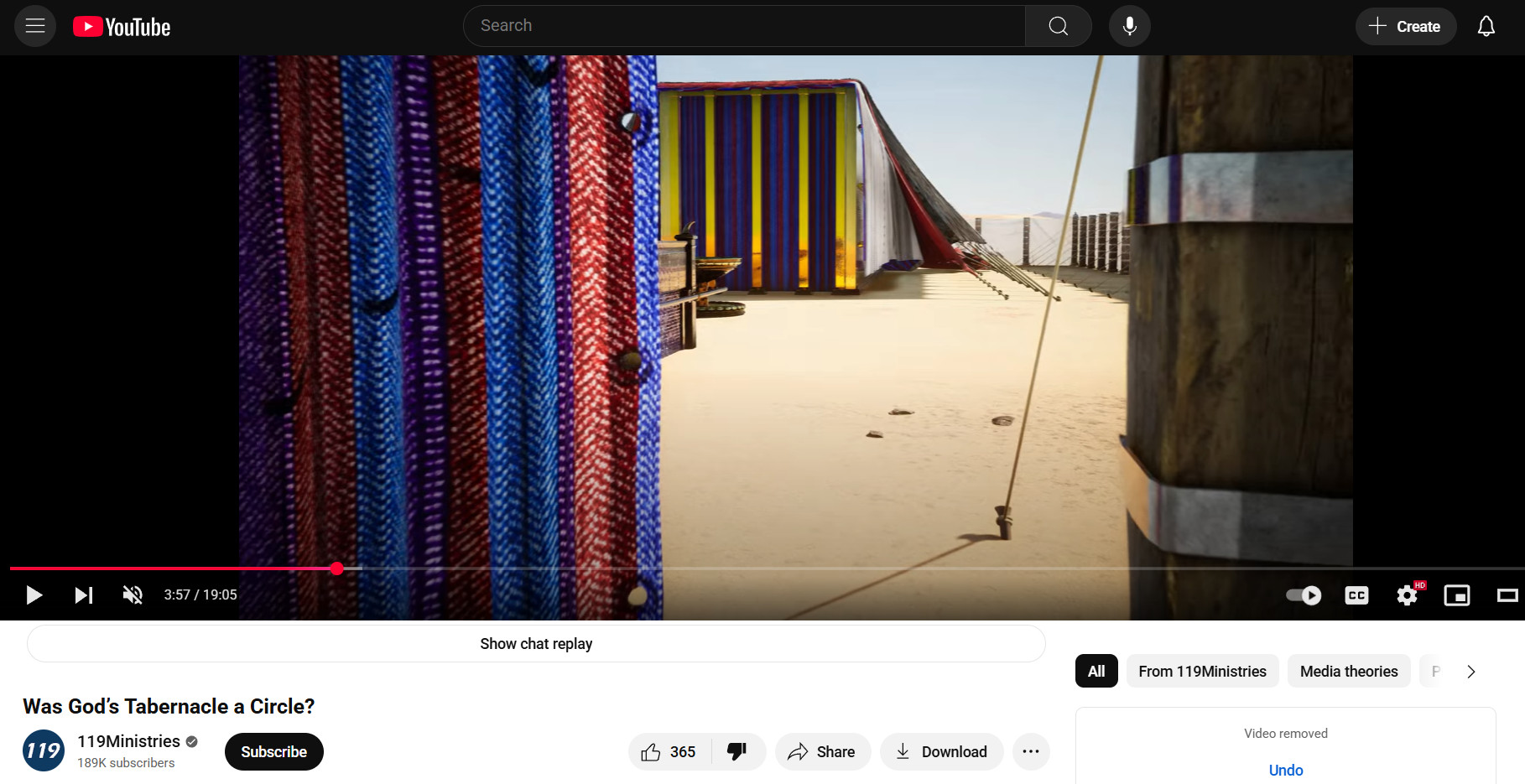
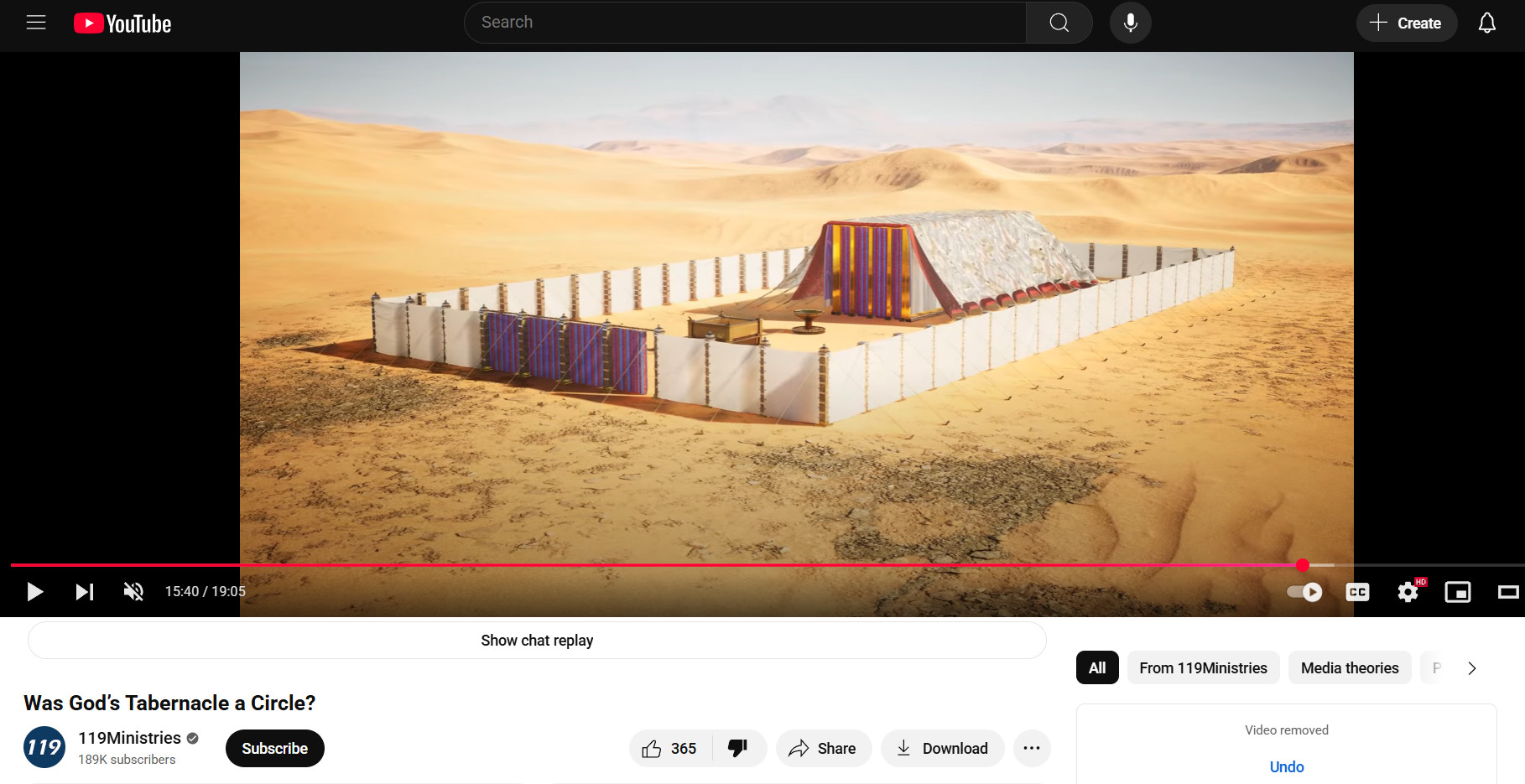
| RECTANGULAR TABERNACLE PROBLEMS: COURTYARD RELATED | ||
| No. | 119 Ministries' Box Tabernacle Error (@2:00, 3:47, & 15:40 Timestamp) |
Why are 119's Models in Violation per the Bible, Physics, or Real-World Standards |
| 1 | Shows wood material being used instead of metal for courtyard posts. | Exodus 27:9-19 calls for copper and makes no mention of wood being used in the courtyard frame. |
| 2 | Shows all courtyard frame posts boxing in, rather than encircling סביב (i.e., saviv, not sovav) around the Tabernacle. | Exodus 27:17 describes pillars as being "round about" by using saviv סביב (H5439). Court posts ENCIRCLED aROUND, the Tabernacle, installed נגב ותימנה clockwise (south and rightward). |
| 3 | Shows five gate posts instead of four gate posts. | Exodus 27:16 plainly calls for four court gate posts. No translation glitches can be blamed here. This is the first case of many dishonest weights / measures / counts. |
| 4 | Shows 56 extra court curtain panels made / added based on misinterpretation Exodus 27:9. | Exodus 27:9-19 is describing the metal frame or "slings" (קלעים) on which to hang fabric curtains, not calling for more curtains to be made. |
| 5 | Fails to show 11 wool court curtains measuring 30 each, joined together at opposite ends. | Exodus 26:7-13 specifies curtains used to encircle courtyard, are specified installed על צדי, that is "over the sides" of the Tabernacle curtains of Ex 26:1. |
| 6 | Shows four curtain rods only above gate curtains, unlike elsewhere on courtyard. | Exodus 27:9-15 court parts list uses same terms as verses 16-17. The entire courtyard needs curtain rods (or curtains would tear). They are קלעים slings. |
| 7 | Shows extra silver being used as curtain band mechanism and top tether connector. | Exodus 38:28 only allows 1,775 shekels for court posts (amounting to only about 9 ounces [about a half of a pound] per each of the 60 posts). |
| 8 | Shows extra (21 instead of 20) court posts on south and north side. | Exodus 27:9-11 calls for 20 posts on the north and south sides of the courtyard. A rotating overlap layout approach causes dimensional spec conflicts. |
| 9 | Shows 100 cubit court length with 21 posts, but ignores 20 post spans 100 cubit length specification. | Exodus 27:9 and 11 call for 20 posts (not 21 posts) spanning 100 cubits, but overall courtyard length per Exodus 27:18 is 100 cubits (CGI shows 21 posts). |
| 10 | Shows extra post (should be 10 posts, not 11 posts) on west side of courtyard. | Exodus 27:12 calls for 10 posts on the west sides of the courtyard. The rotating (not double counting corners) approach creates dimensional conflicts. |
| 11 | Shows 50 cubit court length with 11 posts but ignores 10 post 50 cubit span length specification. | Exodus 27:12 calls for 10 posts (not 11) spanning 50 cubits on the west side of the court, so 11 post span conflicts with 50 cubit width per Exodus 27:18. |
| 12 | Shows 3 courtyard posts spanned only 10 cubits (3 posts at 5 cubit span), instead of 3 posts at 15 cubits span (3 posts at 7.5 cubits span). | Exodus 27:14-15 calls for a span of 15 between 3 posts, making the distance 15/2 and not 15/3. |
| 13 | Shows ropes tying down courtyard gate posts despite none being listed in Exodus text. | Exodus 27 never calls for use of courtyard rope tethers. |
| 14 | Shows all courtyard posts installed above ground while putting imaginary stakes into the ground. | Exodus 27:19 describes the pillars containing (translated as "vessels) the courtyard as pins. Exodus 27:19 specifies buried court post ends (pins). |
| 15 | Fails to show Tabernacle courtyard measuring "width fifty in fifty" per literal English Bibles. | Exodus 27:18 calls for a courtyard "width of 50 by 50" or רחב חמשים בחמשים. This cannot be accounted for assuming rectangular court paradigms. |
| 16 | Fails to show how 15 cubit court post span and 30 cubit wool curtain correlate. | Exodus 27:14-15 calls for the court curtains (of Ex 26:7-13) to be divided at two "flanks", each spanning at 7.5 cubits (3 posts spanning 15 cubits is 15/2). |
| 17 | Shows court gate curtains hanging from rods AND ALSO using silver collars on post side. | Exodus 27:9 Hebrew describes the Tabernacle court as being metal "slings". Court curtains hanging only from sides would be stressed. |
| 18 | Shows metal allocated to court post bases but almost none for a complete system of court hanging rods (only added at gate). | Exodus 27:9 describes the court frame as metal "slings". Hanging curtains from sides stresses fabric. Copper rods required; post bases NOT required. |
| 19 | Shows perpendicular tether arrangement that is not ideal for lateral load restraint (allowing lateral post movement and curtain strain). | Exodus 27:19 calls for pinned court posts. Tether ropes not required. If tethers were used, diagonal staggering would reduce corner post rope loads. |
| 20 | Fails to show how silver collars are employed or secured to wood posts or curtains. | Exodus 27 never calls for wood posts, or for that matter, silver collars around them, but calls for a court frame to sling curtains with 50 loops at ends. |
| 21 | Shows holes in gate curtain not called for and misaligned relative to silver hook collars. | Exodus 26:7-13 calls for curtains made with 50 loops, but there is no mention of court gate curtain grommet holes or bungee cords. |
| 22 | Shows misapplied, unspecified, and pointless silver collars on all courtyard posts. | Exodus 38:28 allows only enough silver for a copper-rod-to-copper-post tee connection. Court rods "slings" the curtains and secures them by loops only at posts at curtain ends. |

| RECTANGULAR TABERNACLE PROBLEMS: LINEN CURTAIN RELATED | ||
| No. | 119 Ministries' Box Tabernacle Error (@9:00 Timestamp) |
Why are 119's Models in Violation per the Bible, Physics, or Real-World Standards |
| 23 | Shows linen curtains attached at the long (warp, not weft) edges, which are the wrong edges. | Exodus 26:4-5 describes curtains being attached at the "outermost" end/edge using terms שפת ,קצה, and הקיצונה. This is the short edge corresponding to the weft edge loom poles. |
| 24 | Shows 10 linen curtains spanning over roof, even though curtains form bounding wall perimeter. | Exodus 26:1 describes curtains as defining the dwelling place. Because strips are long and narrow, and all joined at opposite edges, they must be a ring to enclose a space, thus forming walls. |
| 25 | Shows linen curtain sag as roof, even though curtains are to be tensioned based on יריעת | Exodus 26:1-6 uses יריעה and יריעת, which refers to quivering things, which would be indicative that they would be not limp, but under tension. |
| 26 | Shows linen curtains stressed at west corners of structure. | Exodus 26:1-6 uses יריעה and יריעת. Quivering things would not be loaded in the center. Fabrics pulled over corners are subject to wear, tearing, and puncture and are not capable of quivering. |
| 27 | Shows linen curtains bunched up at west end of structure. | Exodus 26:1-6 uses יריעה and יריעת. Quivering things would not be bunched in a heap. End fabric serves no apparent purpose and are hard to manage. |
| 28 | Shows linen curtain ends and corners sitting in the dirt under scaled (approximately 2 cubits of length sit in dirt). | Exodus 26:1 describes curtains as dwelling place boundaries. Curtain ends sitting in the dirt (approximately [8x8+9x9]^0.5) can’t quiver and fails to act as boundary, wicks water, and rots. |
| 29 | Shows two sets of five narrow curtains joined to make a 40 cubit long x 28 cubit wide patch. | Exodus 26:1-6 describes the construction of a ring or polygon. Long and narrow fabric strips are specified to be suspended (quivering) to create a walled perimeter, not a roof. |
| 30 | Fails to show 10-14" gaps that would exist between 50 blue loops connecting curtain edges. | Exodus 26:3-5 describes curtains interconnected via only 50 loops, which makes loop spacing at 28 cubits/50 loops, or 10-14 inch gaps between loops. |
| 31 | Fails to show purpose for gold buttons used to join center of two curtain sets on linen curtains. | Exodus 26:3-6 describes curtains (eight) interconnected via 50 fabric loops, with the final two connected also by gold buttons which serve no purpose. |
| 32 | Shows linen curtains as being limp and unsecured. | Exodus 26:3-5 describes 10 curtains, all with 50 loops at opposite ends. This requires ALL curtains to be secured to an adjacent one to make the dwelling. |
| 33 | Shows curtain sets that would have open loops at opposite ends on the east and west sides. | Exodus 26:1-5 calls for all 10 linen curtains to have the same measure and loops on opposite ends for interconnection with an adjacent unit. |
| 34 | Shows 3/4 of all colorful linen artwork as being hidden from regular view. | Exodus 26:1 calls for colorful curtains to be used to bound the dwelling place area (use as walls), not as a ceiling or exterior wall insulation/padding. |
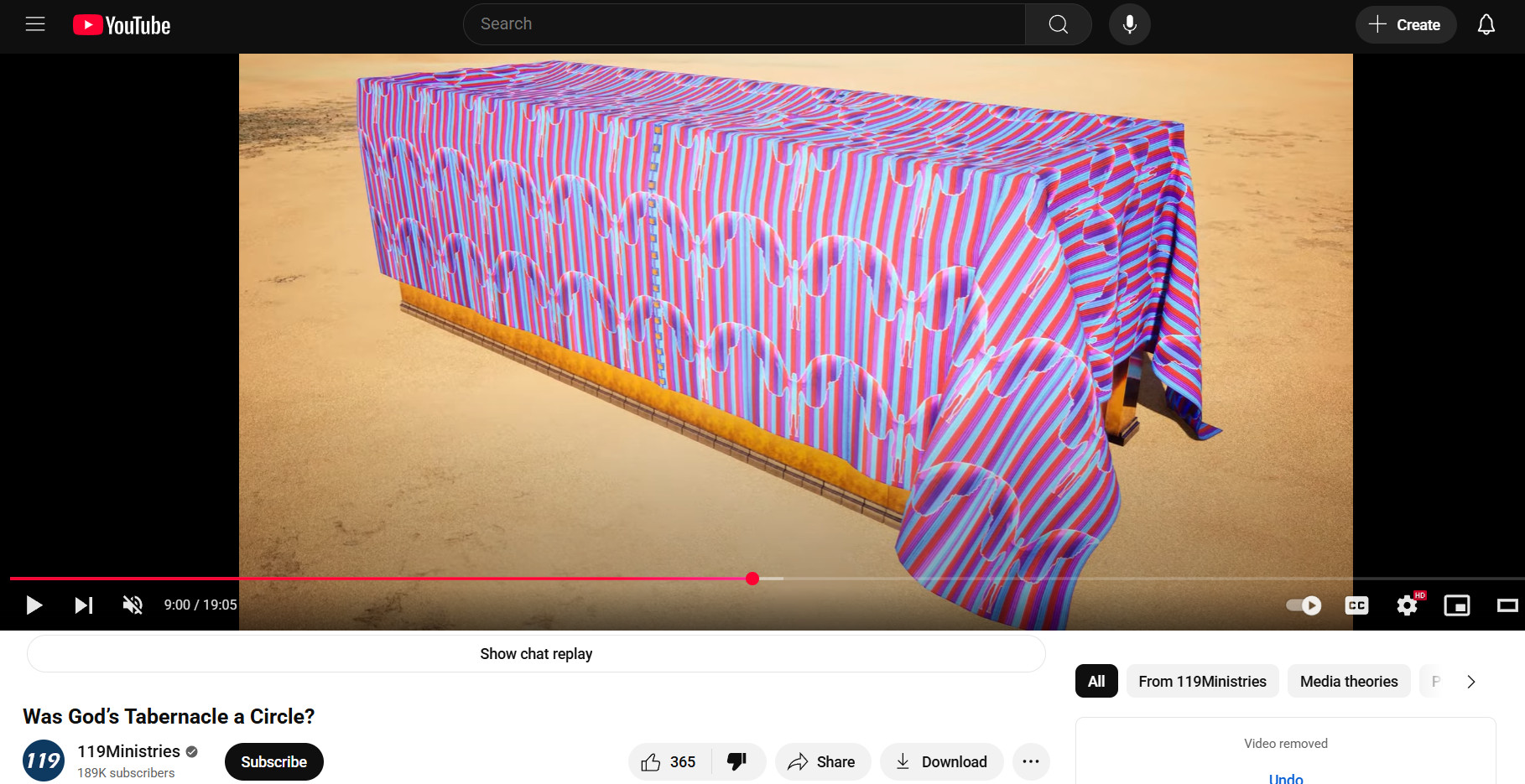
| RECTANGULAR TABERNACLE PROBLEMS: WOOL CURTAIN RELATED | ||
| No. | 119 Ministries' Box Tabernacle Error (@9:01 Timestamp) |
Why are 119's Models in Violation per the Bible, Physics, or Real-World Standards |
| 35 | Shows wool curtains attached at the long edges, which are the wrong edges. | Exodus 26:4-5 describes curtains being attached at the "outermost" end/edge using termsשפת , קצה, and הקיצונה. This is the short edge on the loom. |
| 36 | Shows wool curtains spanning over linen roof, even though curtains form bounding wall perimeter. | Exodus 26:7-13 uses the term על צדי, which is literally "over/on (the) SIDE" of the Tabernacle. Curtain set should not be depicted as over the roof / top. |
| 37 | Shows wool curtain sag as roof, even though curtains are to be tensioned based on יריעת | Exodus 26:7-13 uses יריעה and יריעת, which refers to quivering things, which would be indicative that they would be not limp, but under tension. |
| 38 | Shows wool curtains stressed at west corners of structure. | Exodus 26:7-13 uses יריעה and יריעת. Quivering things would not be loaded in the center. Fabrics pulled over corners are subject to wear, puncture, and tearing and are not capable of quivering. |
| 39 | Shows wool curtains bunched up at west end of structure. | Exodus 26:7-13 uses יריעה and יריעת. Quivering things would not be bunched in a heap. End fabric serves no apparent purpose and are hard to manage. |
| 40 | Shows wool curtain ends and corners sitting in the dirt and under scaled (over 4 cubits length sit in dirt). | Exodus 26:7-13 describes curtains as a side (i.e., wall) covering. Curtains sitting in the dirt (approximately [10x10+11x11]^0.5) fails to act as boundary, wicks, and rots. |
| 41 | Shows two sets of narrow curtains (5+6) joined to make a 42 cubit long x 30 cubit wide patch. | Exodus 26:7-13 describes the construction of a ring. Long and narrow fabric strips are specified to create a perimeter measuring 314 cubits, not a roof. |
| 42 | Fails to show 11-15" gaps that would exist between 50 loops connecting edges on wool curtains. | Exodus 26:3-5 describes curtains interconnected via only 50 loops, which makes loop spacing at 28 cubits/50 loops, or 10-14 inch gaps between loops. |
| 43 | Fails to show purpose for copper buttons used to join center of two curtain sets. | Exodus 26:11 describes curtains (eight) interconnected via 50 fabric loops, with the final two connected also by copper buttons which serve no purpose (prone to snagging on curtains below). |
| 44 | Shows wool curtains as being unsecured and depicting extra loops (gaps or spans between loops would be larger than depicted). | Exodus 26:7-10 describes 11 curtains, all with 50 loops at opposite ends. This requires ALL curtains to be secured to an adjacent one to make the dwelling. |
| 45 | Shows curtain sets that would have open loops at opposite ends on the east and west sides. | Exodus 26:7-10 calls for all 11 curtains to have the same measure and loops on opposite ends for interconnection with an adjacent unit. |
| 46 | Shows wool curtain completely covering decorated linen curtain exterior. | Exodus 26:13 specifies wool curtain to be installed over the SIDES of tent made by the smaller Tabernacle curtain set, NOT over the top. |
| 47 | Shows last / west wool curtain as unfolded and under scaled (curtain to be folded in half). | Exodus 26:9, 12 describes the final curtain as being doubled or coupled or folded over in half. |
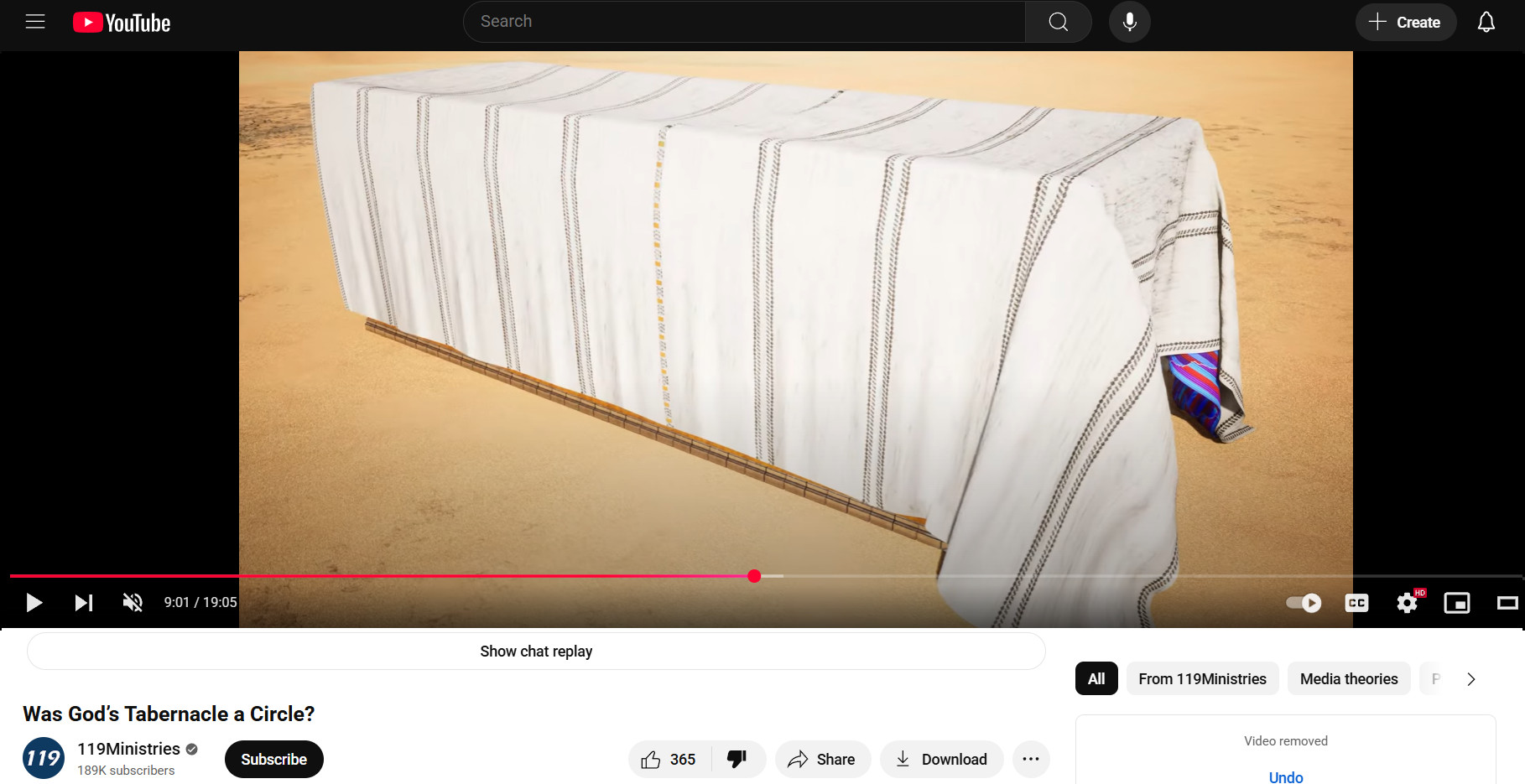
| RECTANGULAR TABERNACLE PROBLEMS: LEATHER ROOF RELATED | ||
| No. | 119 Ministries' Box Tabernacle Error (@9:05 Timestamp) |
Why are 119's Models in Violation per the Bible, Physics, or Real-World Standards |
| 48 | Shows red colored or treated leather roof covered by an upper layer, rendering color or treatment on lower layer useless. | Exodus 26:13 calls for two leather roof (sections), an upper and a reddened one. There would be no reason of color a lower layer if it were to be covered. |
| 49 | Shows ropes and stakes for securing leather. | Exodus 26:13 mentions only the leather and calls for neither stakes nor ropes. |
| 50 | Shows flat roof and projecting awning at east end of the structure. | Exodus 26:15-37 does not provide mention of or materials for a rigid roof extension at entrance. A flat roof offers no watershed, resulting in ponding from rain or dew. |
| 51 | Shows tethers pulling roof toward only west end with no fastening on east end. | Exodus 26:13 mentions only the leather and calls for not stakes or ropes. Pulling the roof only in one direction would shift roof layer over time. |
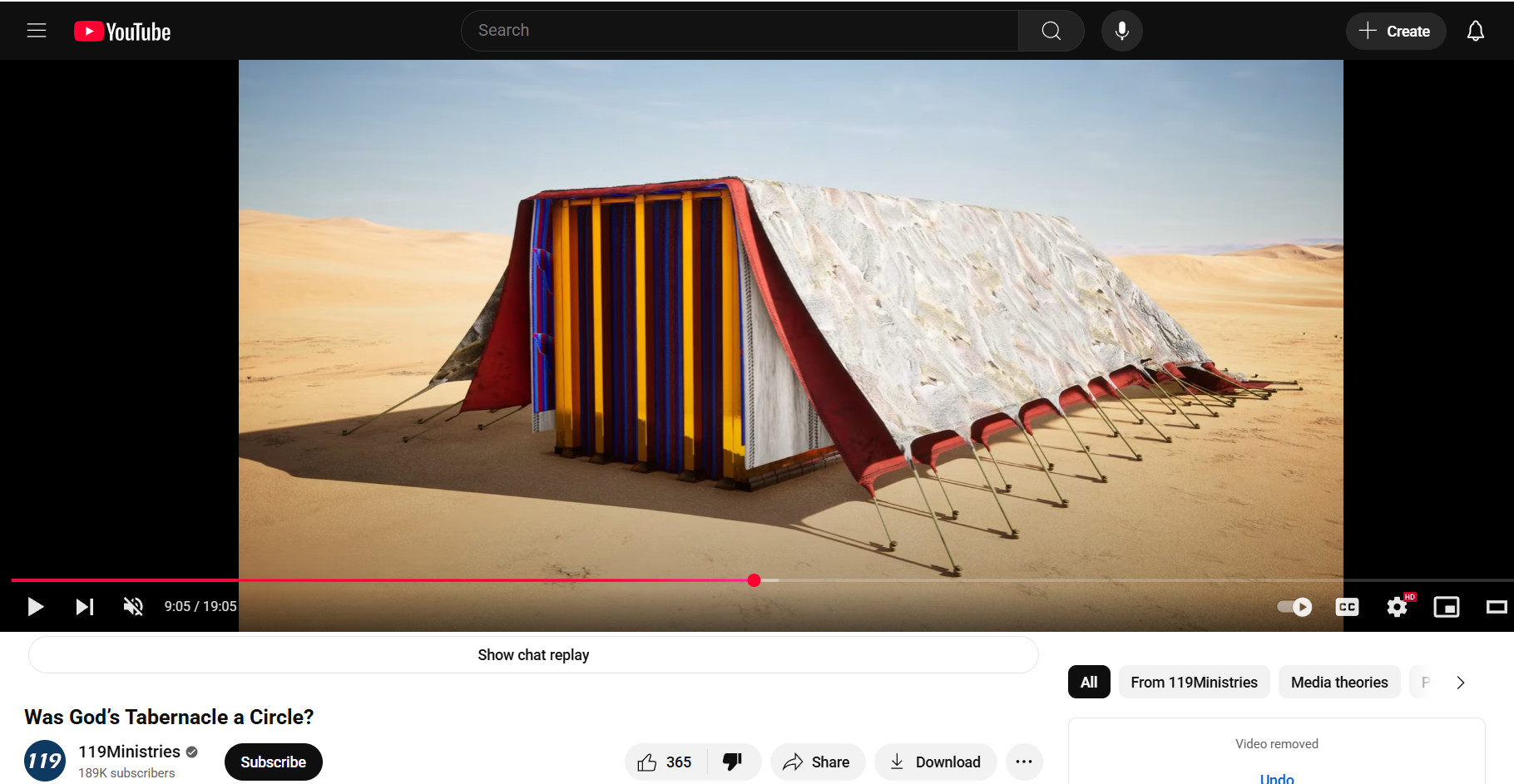
| RECTANGULAR TABERNACLE PROBLEMS: TENT FRAME RELATED | ||
| No. | 119 Ministries' Box Tabernacle Error (@1:41, 15:05, & 15:07 Timestamp) |
Why are 119's Models in Violation per the Bible, Physics, or Real-World Standards |
| 52 | Shows planks with 3 dimensional characteristics but assumes 2d size of 10 x 1.5 cubits. | Exodus 26:15 calls for a 10 L x 1 W x 0.5 W plank. A two dimensional board (with only a length and width) is not physically viable for purposes of construction. |
| 53 | Shows planks up to 3 times thicker/wider and heavier than Bible specifies. | Exodus 26:15 calls for a 10 L x 1 W x 0.5 W plank, not a 10 L x 1.5 W x 1 D plank like Jewish scholars suggest. |
| 54 | Shows additional horizontal wood stubs on wood plank. | Exodus 26:15-22 makes no mention of stubs being added to the planks. |
| 55 | Shows wood stubs but doesn't account for stubs in length and width dimensions. | Exodus 26:15 list overall beam size but make no mention of extension (overall structure size would be reduced if stubs were included in overall measurement. |
| 56 | Shows thick wood tent walls, where tents always use solid frames and pliable or fabric walls. | Exodus 26:18 describes the wood frame members as spanning fabric out to the edge or lip of the tent. |
| 57 | Shows a structurally dysfunctional and pointless horizontal north bar arrangement. | Exodus 26:26-27 calls for bars, which provide virtually no torsional resistance. |
| 58 | Shows separate frame sections (see 9:13) covered up like seamless mirrors (1:41) | Exodus 26:15 calls for single beams, not multi-piece frames. If wood planks were frames, gold per Ex 26:29 would need to be overlaid into the housing. |
| 59 | Shows thin and fragile gold layer over both front and back of boards, exterior gold not visible. | Exodus 38:24 calls for than 30 talents of gold, only about (0.001" to 0.003") thick or 1/4 of the thickness of human hair, depending upon cubit size. Foil covered boards would not endure transport. |
| 60 | Shows fragile gold layer subjected to extreme pressure and abrasion. | Exodus 38:24 calls for than 30 talents of gold, only about (0.001" to 0.003") if covering all boards; thin fragile gold would tear from handling and rubbing. |
| 61 | Shows gold mirror finish and precision edge fit on wood subjected to moisture and warpage. | Exodus 26:15 calls for קרשים planks, which would warp from moisture exposure via air and ground. Precision fir and plane mirror finish not possible. |
| 62 | Shows horizontal north side bars that would demand precision alignment and leveling. | Exodus 26:26-27 calls for bars, but rings would be difficult to align if bars fit in ring tightly. If wood bars don’t fit tightly into rings, bars would fail to offer structural benefit. |
| 63 | Shows horizontal north side bars at arbitrary lengths without any basis for sizing. | Exodus 26:26-27 calls for bars, a mixture of different lengths is of no structural benefit, and actually a detriment. Unsupported tops and bottoms would be subject to more movement. |
| 64 | Shows horizontal north side bars arbitrarily placed without any basis for arrangement. | Exodus 26:26-27 calls for bars, staggering half-length bars from top to bottom and east to west top down is of no advantage, especially as wood bars offer no torsional restraint. |
| 65 | Shows multiple gold ring(s) joining north bars to wall. | Exodus 26 never specifies gold rings attached to walls or encompassing bars. Exodus 26:29 refers to gold housings in the "one ring" of Exodus 26:24. |
| 66 | Shows front of roof tensioned downward and outward restrained by an unspecified inner upper ceiling brace. | Exodus 26:36-37 calls for five copper balances, but image shows five copper bases and four upper lateral braces added in up top not called for in Exodus. |
| 67 | Shows no bottom lateral bracing, resulting in stability and shaping problems. | Exodus 26:19 calls for silver "sockets" or "bases" per English translations, but parts are not heavy enough (1 talent per Ex 38) to anchor heavy wood planks or frame assembly in place. |
| 68 | Shows an unspecified horizontal (or 3 piece?) brace at the top of and in between four Holy of Holies poles. | Exodus 26:32 makes no reference of 3 braces (or a single bracing pole) installed between the tops of Holy of Holies posts. |
| 69 | Shows 4 massive (oversized) posts maybe 6" or more to support a fabric curtain and four layers of fabric roof. | Exodus 26:32 does not describe such large posts. The curtain and roof could easily be supported by horizontal brace or rod attached to outer walls. |
| 70 | Shows 4 posts with hooks with holding the curtain up while not using the depicted curtain rod. | Exodus 26:32 gold "hooks" are not merely used for curtain holding, rather they are pegs used for holy of holies post attachment . |
| 71 | Fails to show how Holy of Holies top brace (or 3-piece braces) are secured to N/S walls or laterally restrain the posts. | Exodus 26:32 makes no reference of 3 braces installed on Holy of Holies posts, and Exodus 26:15-22 make no mention of Holy of Holies mating features. Posts freestanding on dirt base would tip. |
| 72 | Shows an unspecified horizontal (1 or 4 piece?) brace at the top of and in between five east entrance posts | Exodus 26:36-37 makes no reference of 4 braces (or a single bracing pole) installed between the tops of entrance screen posts. |
| 73 | Shows 5 massive oversized posts maybe 6" or more to support a fabric curtain and four layers of fabric roof. | Exodus 26:36-37 does not describe such large posts. The curtain and roof could easily be supported by horizontal brace or rod attached to outer walls. |
| 74 | Shows 5 posts with hooks with holding the curtain up while not using the depicted curtain rod. | Exodus 26:36-37 bronze "hooks" are not merely used for curtain holding, rather they are pegs used for entrance screen post attachment. |
| 75 | Fails to show how the unspecified (1 or 4-piece) top entrance screen post braces secure to N/S walls or laterally restrain the five post tops. | Exodus 26:36-37 makes no reference of 4 braces installed on entrance screen curtain posts; Exodus 26:15-22 mentions no wall mating features. |
| 76 | Shows two beams on the outer (as opposed to inner) west "corners", not accounting for extra leather and fabric stresses created. | Exodus 26:23-24 describes a ring (טבעת) that is made by two bent or angled cut eye segments (מקצעת), not an exterior rectangular "corner" protrusion. |
| 77 | Fails to show how a lone ring attaches north and west beams at the west exterior "corners". | Exodus 26:23-24 describes a wood ring (טבעת) that is made by two bent or angled cut eye segments (מקצעת), not a metal ring. |
| 78 | Fails to show the Holy of Holies "in the midst" of the tribes, showing an asymmetrical arrangement instead. | Exodus 25:8 and Isaiah 37:16 describes the sanctuary (by extension the holy of holies) as being "in the midst" of Israel, which is unlike an offset rectangle. |
| 79 | Shows wood walls as being the Holy of Holies barrier, when only the fabric veil was specified. | Exodus 26:33 describes a veil and nothing else separating the Holy place from the Most Holy place, ergo, the veil must be cylindrical. |



| RECTANGULAR TABERNACLE PROBLEMS: ARTICLE RELATED | ||
| No. | 119 Ministries' Box Tabernacle Error (@1:49, 3:50, & 6:30 Timestamp) |
Why are 119's Models in Violation per the Bible, Physics, or Real-World Standards |
| 80 | Shows a square altar, which would have terrible airflow, heat distribution, and combustion. | Exodus 27:1 describes the altar as being רבוע or quartered or four legged, not as a right-angled cuboid or box. |
| 81 | Shows Ark of the covenant with high poles and low poles and with mismatching lid and box sizes. | Exodus 25 describes the Ark top and bottom being of matching measurements (2.5L, 1.5W). CGI does not depict these dimensions as matching in either image. |
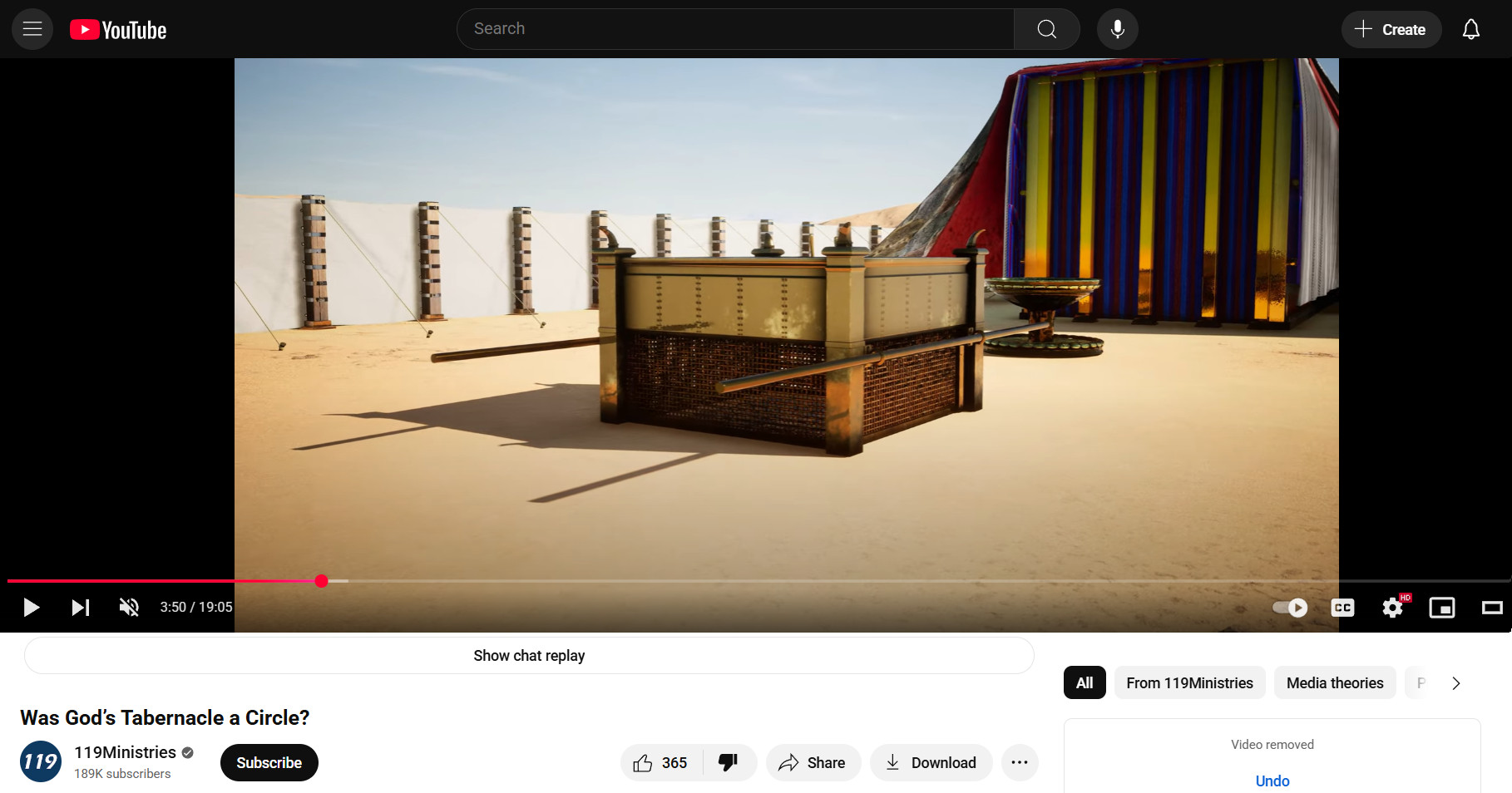
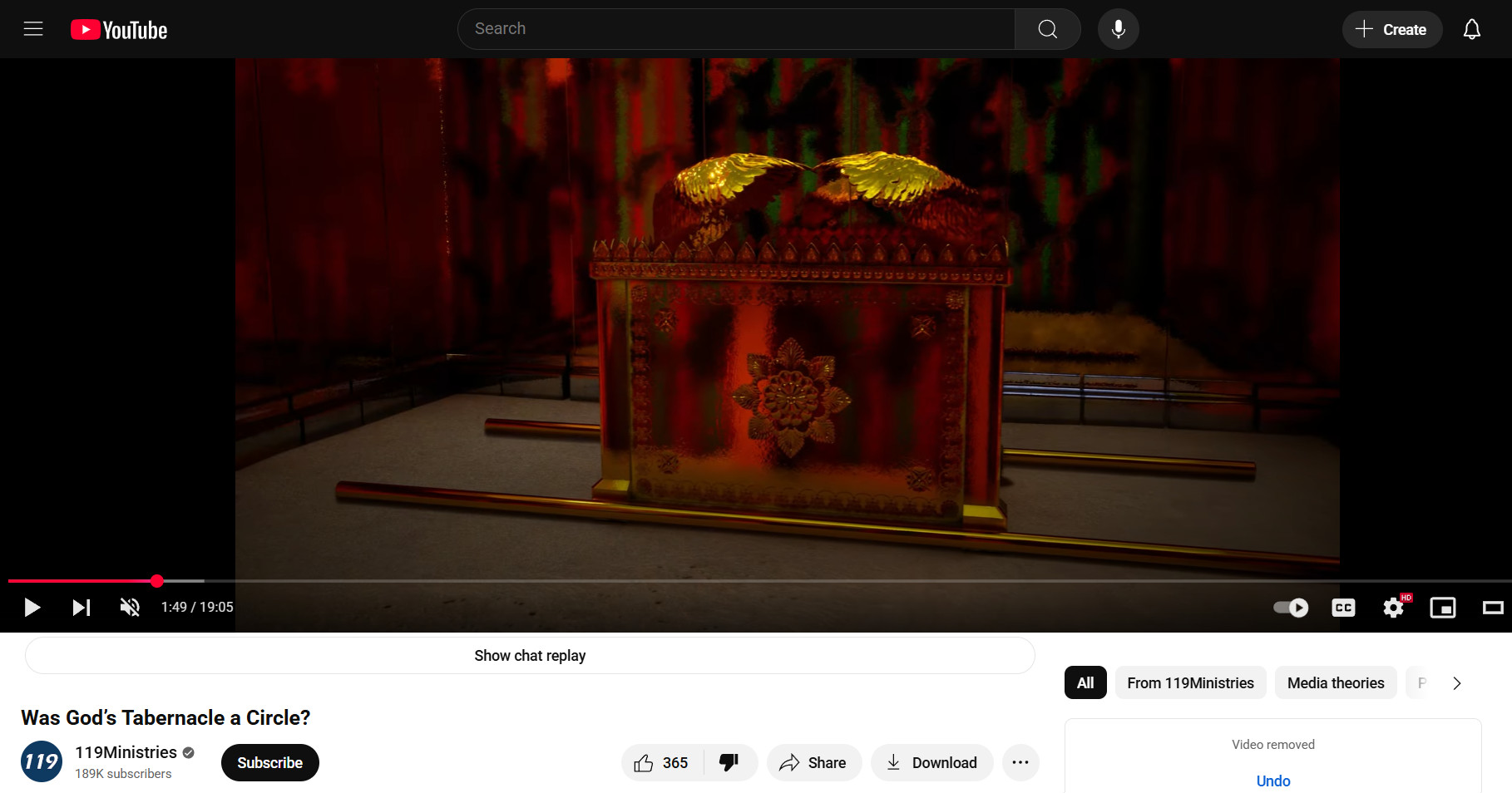
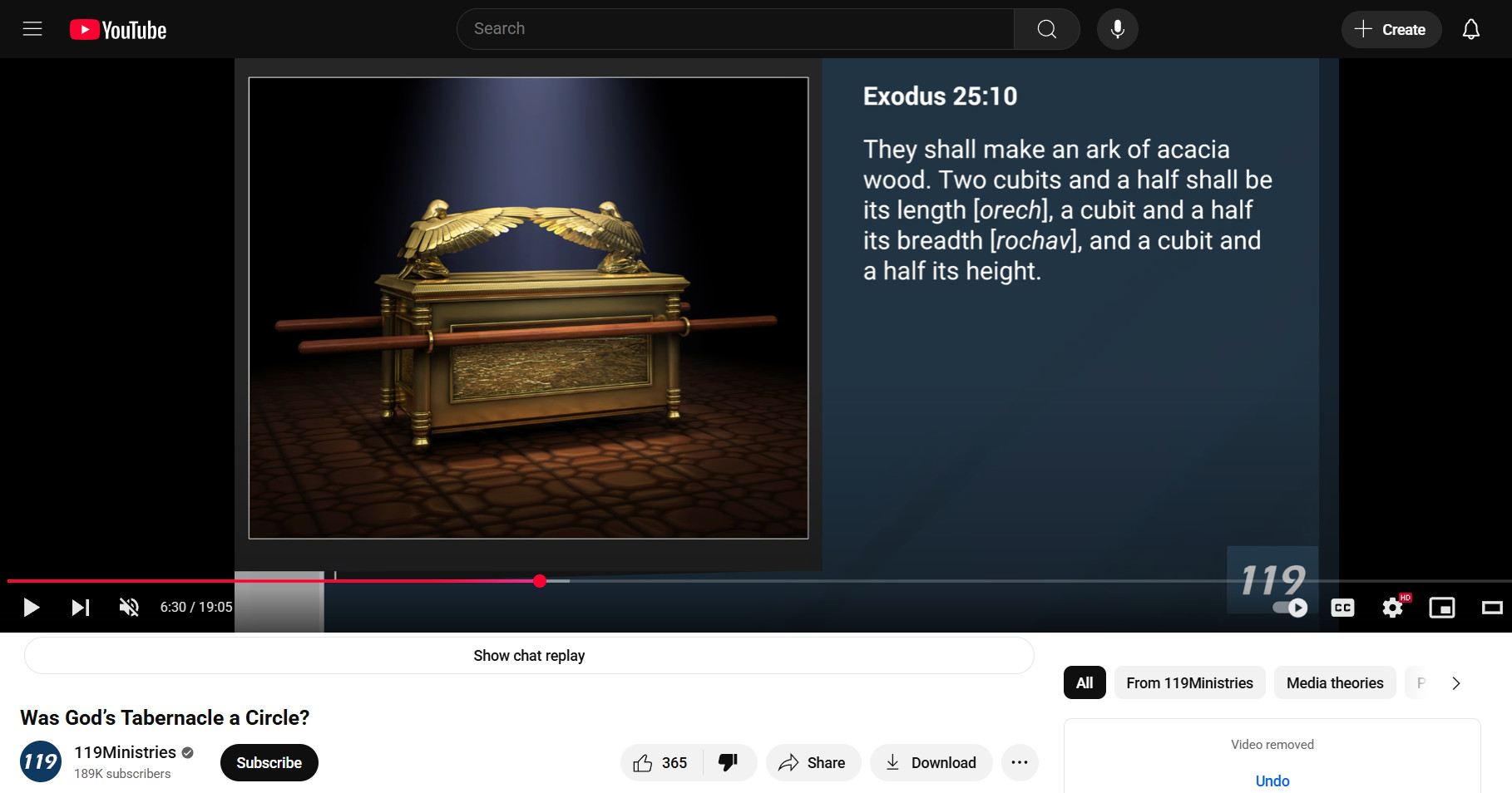
| RECTANGULAR TABERNACLE PROBLEMS: LOGISTICAL RELATED | ||
| No. | 119 Ministries' Box Tabernacle Error (@1:41 and 2:00 Timestamp) |
Why are 119's Models in Violation per the Bible, Physics, or Real-World Standards |
| 82 | Shows the altar of incense and its handles as obstructing the path to the Holy of Holies. | Exodus bare ground may have been Holy, but it is impractical to conclude that the Ark of the Covenant was sitting low in the dirt. |
| 83 | Shows tightly fitted and heavily covered wood plank walls, creating an incense smoke trap. | Exodus describes prayers offerings as divine smells or fragrance, as to reach heaven. A sealed Tent would negate that principle and obstruct the pathway. |
| 84 | Shows small bird-bath like laver in poor proximity to Tabernacle tent entrance. | Exodus 30:18 specifies laver placement between the altar and entrance and altar for washing. Laver should be close to tent like a welcome mat at a door. |
| 85 | Shows the courtyard occupying a large open dead field space as if it were an animal pasture. | Exodus through Deuteronomy never made mention of an animal being led inside of the Tabernacle courtyard. |
| 86 | Shows altar stranded in the middle of court requiring extra legwork and logistical and housekeeping complications. | Exodus 29:11 calls for slaughter "at the entrance to the Tent of Meeting" and Ex 24:6 calls for sprinkling blood at altar. If offered at the box entrance, makes for a messy front tent door. |
| 87 | Shows roof as incapable of shedding water or utilizing captured water. | Exodus 30:18 specifies laver placement between the altar and tent entrance. A laver placed near the tent would allow for dew and rainwater collection. |
| 88 | Shows altar far from courtyard entrance, which requires bull carcass hauling via dragging or carting in and out. | Exodus 29:14 called for burning of carcasses outside the camp. Hauling an animal inside the court and near the Tabernacle is logistical folly. |

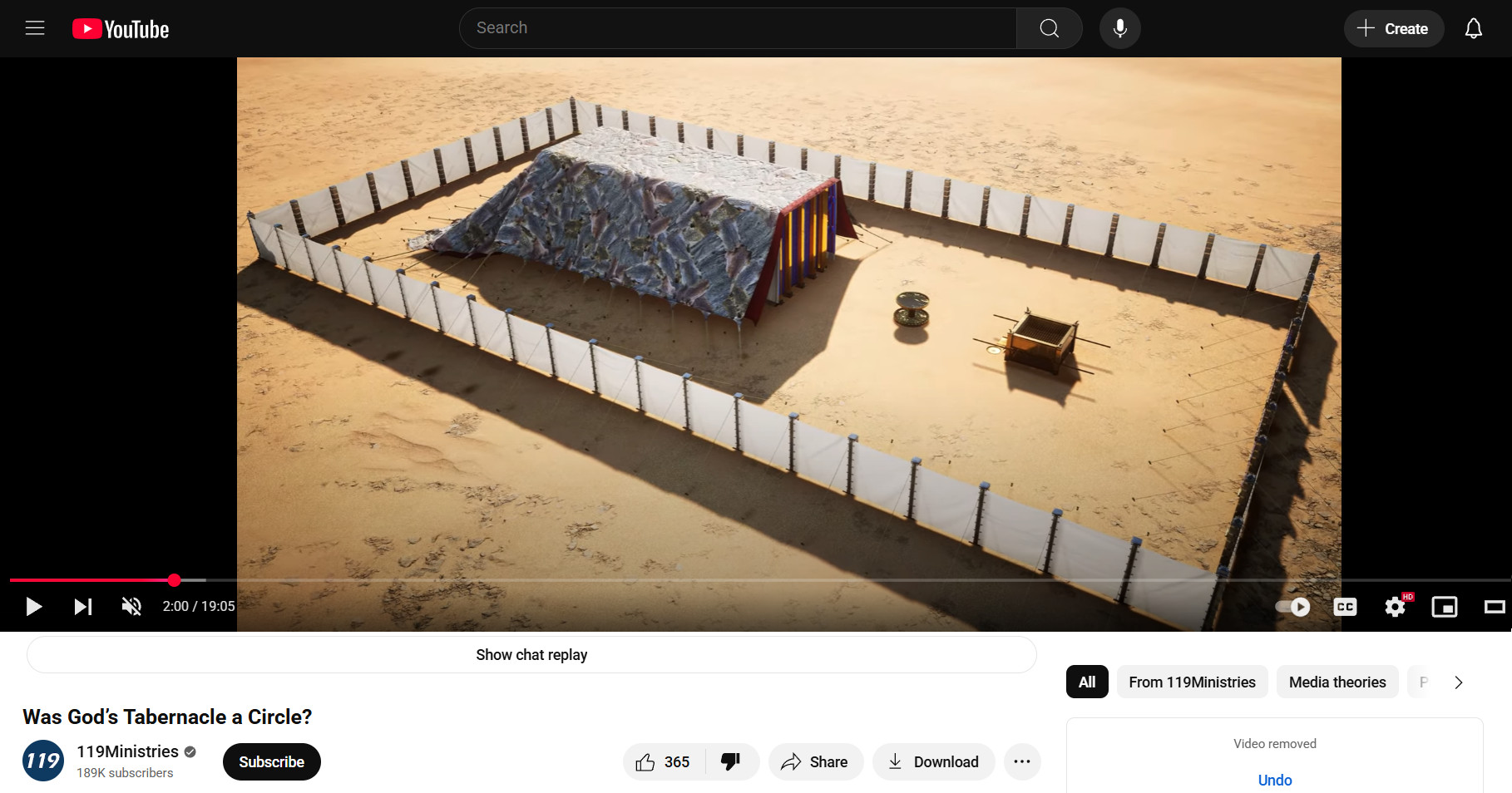
| RECTANGULAR TABERNACLE PROBLEMS: TIMNA RELATED | ||
| No. | 119 Ministries' Box Tabernacle Error (@14:44 Timestamp & Extra Pictures) |
Why are 119's Models in Violation per the Bible, Physics, or Real-World Standards |
| 89 | The Timna Tabernacle model substitutes steel for wood bars. | Exodus 26:26-27 calls for WOOD bars to be used with north, east, and west portions of the Tabernacle, not for metal as an aesthetic substitute. This speaks to the impracticality of interpretation. |
| 90 | The Timna Tabernacle model exhibits representative or symbolic but non-functioning north and south bars. | Exodus 26:26-27 employs "bars" as for first and second walls (Exodus 26:1), whereas the west (or skyward) "bars" support the west (or skyward) "flank". |
| 91 | The Timna model shows 5 entrance screen bars spanned on end of wall instead of in between. | Exodus 26:27, 37 and imply an interior arrangement as entrance screen bar count (5) matches the west (skyward) column count (5). |
| 92 | The Timna Tabernacle shows linen curtains to be red, blue, and purple, and adds white also. | Exodus 26:1 calls for blue, purple, and scarlet, with no mention of white being made in the text. |
| 93 | The Timna Tabernacle shows linen curtains tethered to the ground. | Exodus 26:1-6 calls for no linen curtain ground tethering features or hardware. In contrast, the CGI model shows linen curtains to hang loose and unsecured. |
| 94 | The Timna Tabernacle does not include representations of the wool curtains. | Exodus 26:7-13 calls for curtains 314 or 315 in length to create a perimeter. The CGI model shows wool curtains above the colored linen layer. |
| 95 | The Timna Tabernacle employs 21 courtyard posts on north and south sides, but 10 on the east. | Exodus 27:9-11 only calls for 20 posts on the north and south sides. The CGI model shows 11 posts on the east side. |
| 96 | The Timna Tabernacle features unspecified galvanized braces bearing both compressive and tension load. | Exodus 26 makes no mention of wall braces on the Tabernacle's side. The CGI model shows tie down ropes in tension which are likewise not specified. |
| 97 | The Timna Tabernacle does not connect the colored linen mockup curtains by blue loops. | Exodus 26:1-4 specifies colored curtains to be made, one like the next, with blue loops used for tie downs. Timna curtains are essentially monochrome. |
| 98 | The Timna Tabernacle employs five unequally spaced spooly round entrance screen posts. | Exodus 26:37 calls for 5 posts but never proposes unequally staggering the posts for the sake of egress size. The CGI model equally spaces square posts. |
| 99 | The Timna Tabernacle pitches the roof with an unspecified center spine to ensure water runoff. | Exodus 26 does not specify a center spine running the length of the Tabernacle. Like the CGI model, most depict full length center bars and a flat roof. |
| 100 | The Timna Tabernacle adds a metal brace above the east entrance to brace supports and walls. | Exodus 26:37 does not call for a single brace to be installed on top of the entrance screen posts. |
| 101 | The Timna Tabernacle uses cables, above and below the curtains, to hold them in place. | Exodus 27 never calls for cables. Exodus 27:9-15 calls for copper posts and rods, not for cables and copper bases. |
| 102 | The Timna Tabernacle uses decorative and non-functioning silver caps and no silver “collars”. | Exodus 27:9-18 calls for a metal frame courtyard made of copper interconnected or hooked together by means of small silver tees. |
| 103 | The Timna Tabernacle fails to use 50 loops on linen curtain edges to connect them. | Exodus 26:1-6 calls for 50 loops joining each curtain (which would leave gaps between curtains. |
| 104 | The Timna Tabernacle fails to use 50 loops on wool courtyard curtain edges to connect them. | Exodus 26:7-13 calls for wool curtains, which were equipped with 50 loops and hung on a frame per Exodus 27:9-18, at a post spacing of 15/2 spans. |
| 105 | The Timna Tabernacle employs deep subterranean anchors beneath the galvanized channels. | Exodus 26 never calls for subterranean anchors. This detail is not evident in the photos but was revealed by a tour guide back in 2016. |
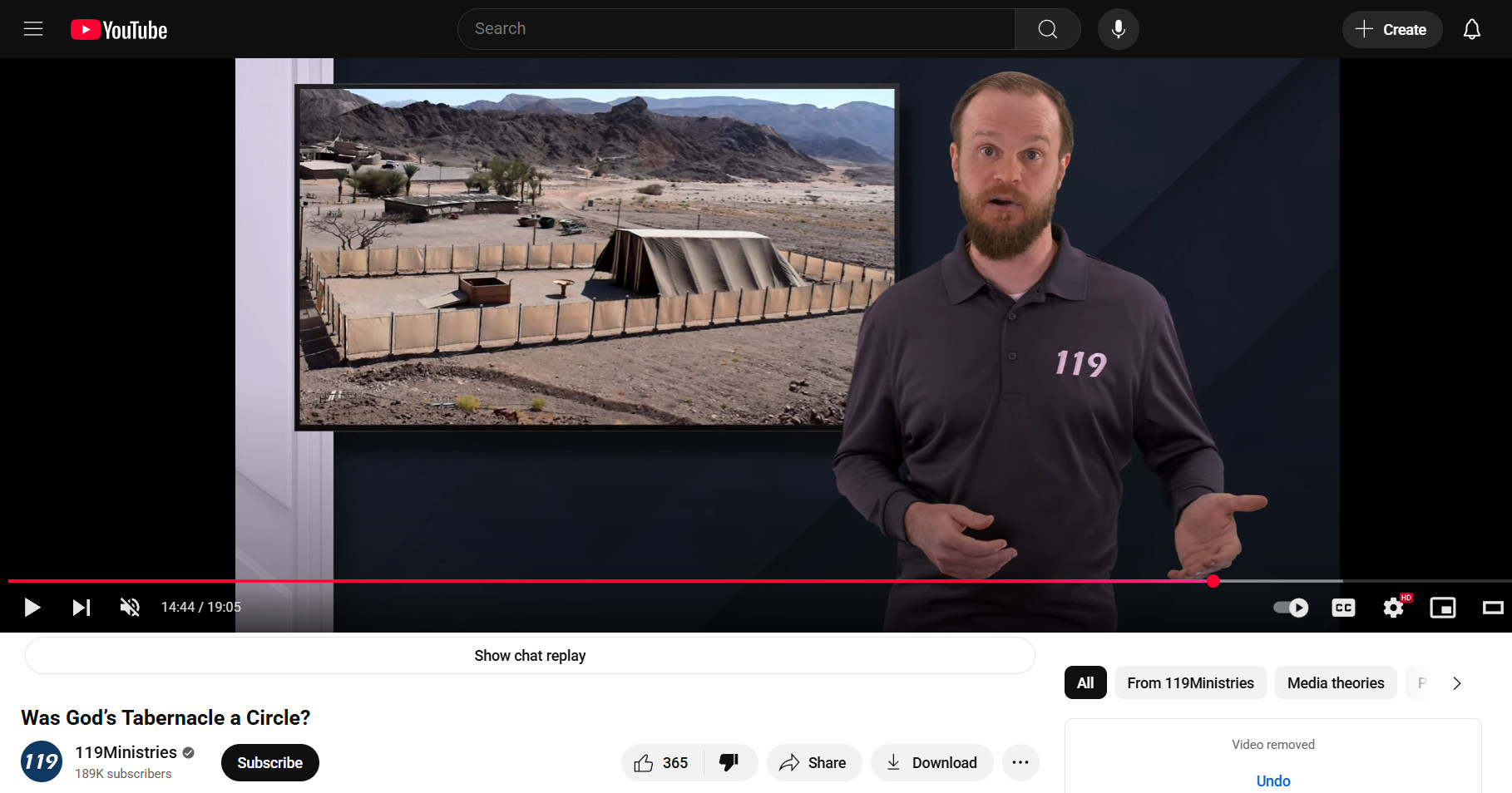

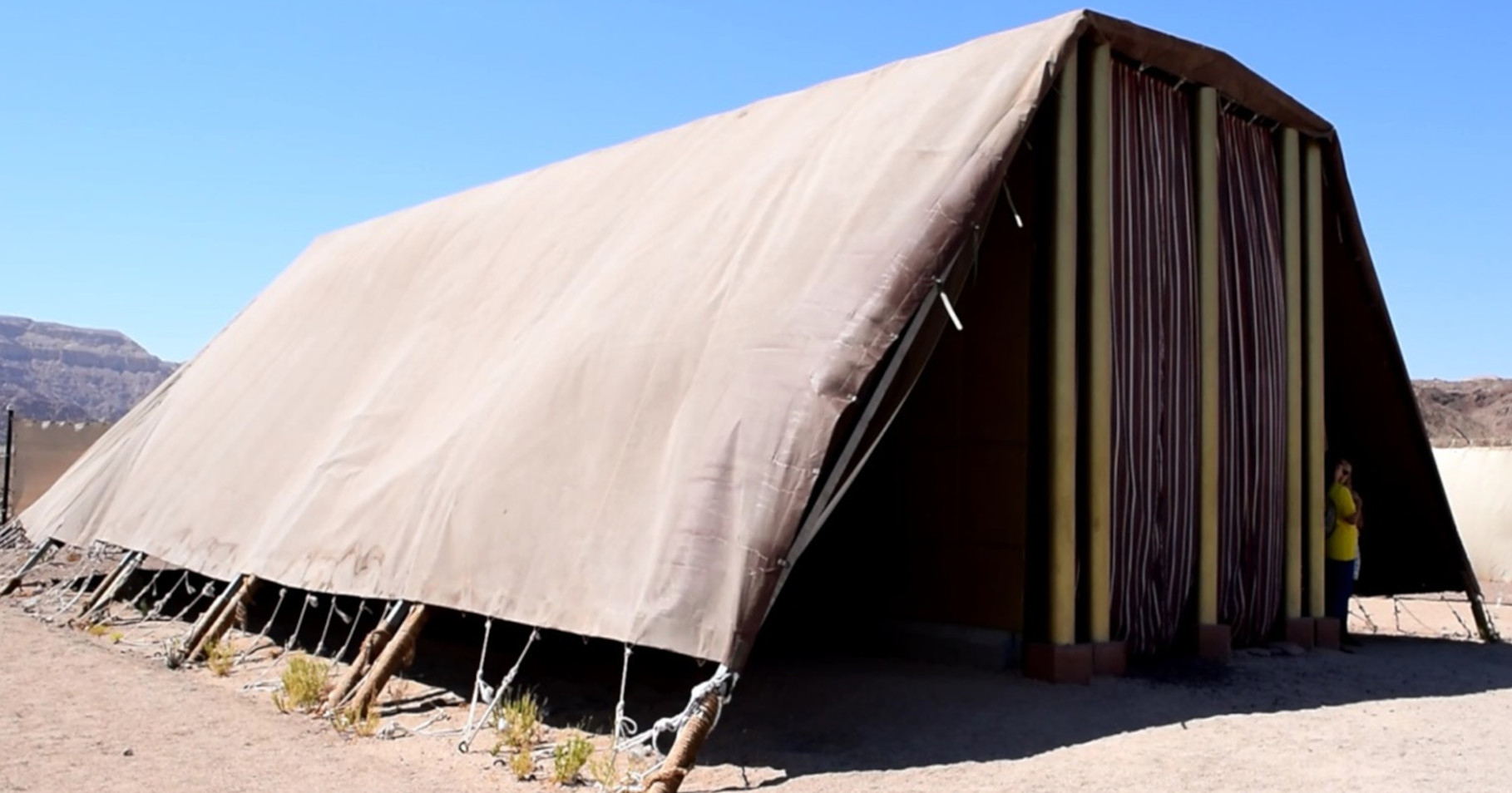
| RECTANGULAR TABERNACLE PROBLEMS: HEBREW RELATED | ||
| No. | 119 Ministries' Box Tabernacle Error (@6:09, 13:30 Timestamp) |
Why are 119's Claims and Reasoning in Violation per the Bible, Physics, Language, Logic, or Real-World Standards |
| 106 | Cites wrong Strong's reference (H748) orech ארך in making Exodus 27 length references. | Exodus 27 "length" or orech references the noun Strong's H753, not the verb H748. |
| 107 | Cites wrong Strong's reference (H7337) rochav רחב in making Exodus 27 width references. | Exodus 27 "width" or rochav references the noun Strong's H7341, not the verb H7337. |
| 108 | Restricts Hebrew term use (orech), claiming used limited to rectangles when used with rochav. | Strong's H753 is not limited to measurement of rectangles per BDB or Strong's concordance, as well as Genesis 13:17 and Zechariah 5:2 contexts. |
| 109 | Restricts Hebrew term use (rochav), claiming used limited to rectangles when used with orech. | Strong's H7337 is not limited to measurement of rectangles per BDB or Strong's concordance, as well as Genesis 13:17 and Zechariah 5:2 contexts. |
| 110 | Omits reference to Genesis 13:17 when claiming that "orech" + "rochav" = "rectangle" | Genesis 13:17 describes Abraham's tour of Israel, where it is impossible to assert that he walked through length and width of the land in a rectangle. |
| 111 | Omits reference to Zechariah 2:2 and 5:2 when claiming that "orech" + "rochav" = "rectangle" | Zechariah 2:2 refers to the city of Jerusalem, and 5:2 refers to the dimensions of a roll or a scroll, which is portrayed as something that is cylindrical as opposed to "a rectangle". |
| 112 | Cites wrong Strong's reference to sovav (verb) סבב for "circumference" in 1 Kings 7:23 | 1 Kings 7:23 includes reference to both sovav (סבב or Strong's H5437) and saviv (סביב or Strong's H5439). |
| 113 | Claims there is no "sovav" reference in Exodus Tabernacle texts, while “saviv” is clearly present. | Reference in Exodus Tabernacle texts is not sovav (סבב or Strong's H5437), but saviv (סביב or Strong's H5439). |
| 114 | Ignores saviv סביב reference as "circle" or "circumference" in Exodus, while denying that circle references are present in Exodus texts. | Exodus 27:17 describes pillars being installed "round about", i.e., in a circular or circumferential fashion. |
| 115 | Omits or ignores references to other circle, round, or circular terms, e.g.חג/חגג/חוג, טבעת, הר, שדי , גר, גלגל and נגבה ותימנה. | Bible texts make reference to circle (חג חגג חוג) holiday feasts, the ring (טבעת), Shaddai (שדי or 314), yurt or sojourn (גר), Gilgal / Golgatha (גלגלת, גלגל) and “clockwise” (נגבה ותימנה or נגב). |
| 116 | Claims that קו is found in 1 Kings 7:23. | 1 Kings 7:23 refers to קוה, not קו |
| 117 | Cites wrong spelling of קו in 1 Kings 7:23 (should be קוה) , whereas קן is rather used in 2 Cor 4:2 | 1 Kings 7:23 refers to קוה, not קו |
| 118 | Claims that קו means "circumference" and also says it's "diameter" in YT comments, when it's referring to a line, cord or string. | H6957 speaks to linear spans, not just circumferential measurements, like a cord bundling sticks or measuring a drum or a cord spanning across a hole and a guitar cavity. |
| 119 | Claims that קו “would be used" in Exodus if Tabernacle was round or a dome. | The use of, or the mere mention of a tape measure does not by any means dictate any shape that is being measured, be it round or rectangular. Inspired writ inclusions are not dictated by 119. |
